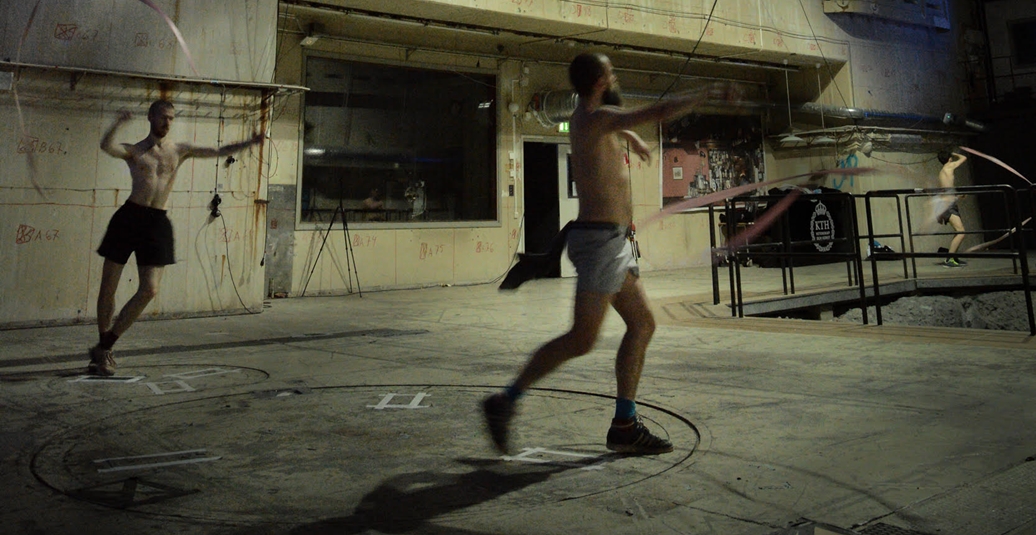“Dad & Son #2 (Ribbon Dance)”, by Frédéric Gies is a dance for two male bodies, performed at DOCK 11 by Samuel Draper and Frédéric Gies, to techno producer Fiedel’s relentless beats.
Lines.
Each movement, a celebration. Each jolt of the hip, each hit of the elbow, each extended limb is followed by a satin streamer, spiralling in its wake. The ribbons soften the sharpness and make the hi-hats circular.
Lab.
The two dancers give themselves over to the sways and peaks of the music, sometimes bouncing, sometimes balancing. Their twists and turns are delicate and feminine, while their marching to the up-beat rhythm is marked by the pulse of the groin. A mix of man and machine, Trisha Brown’s self-sustaining “Watermotor”, an experiment: if the body can create the dance, can the dance create the body?
Box.
White. Thomas Zamolo’s bright square shines from above. Every detail, every expression, every muscle is visible, ruthlessly revealed in razor-sharp detail by the light. Until about three-quarters of the way into the performance, when abruptly, without warning, the room turns bright blue. The neon orange strings hanging from Gies’s jockstrap shake from side to side, like venomous snakes sliding across the desert in the night-time.
Migrate.
They have placed their practice in an entirely different context. Every weekend, they practice their art: it has formed their muscles, shaped their smiles and is tattooed across their skin. Just as contemporary dance left the stage and entered the art gallery, so Gies has moved participatory dance out of the club and into the theatre.
Connect.
It’s easy to imagine the two dancers surrounded by several, half-naked torsos, religiously surrendering to the music and to each other, sweat dripping, strobe lights flashing. Lucid, no need for cheap tricks or special effects. Another place – somewhere very real – is called into being. Perhaps it’s a spiritual awakening. Perhaps it’s a workout. Perhaps it’s a bit of both.
Teeth.
They are joyous beings: they throw smiles as they saunter by, or demonstrate their determination as they prance from the back to the front of the stage. They invite us in, they flirt with us, just as they flirt with each other. Gentle. They are lovers. They are friends. They are father and son. How can they be all of these things? If their relationship transgresses each of these categories, then how can they know which role to play?
Reach.
“I just wanted to be in the club.” said my friend, who was practically jumping off his seat at every cascade in the score. Perhaps he felt seduced, enticed to join them in a collective experience, but left out that he couldn’t go all the way. “But you don’t have to be dancing to be with them.” I said, acknowledging how they had welcomed us as they drifted between phases of inspiration and exhaustion. If the proscenium arch stage requires a different kind of engagement than the full immersion of underground nightlife, how can installed bodies still be transported all the way?
Time.
It is about sharing the moment: a moment that is never predictable, never quite the same as the last, even when the exact same rhythm carries it. Time is obsolete in concrete containers crammed with soul-searchers, the sunlight leaking through the patched-out window panes. Time is an illusion for party troopers on unrelenting dance floors, caught between the thrills and pills of the techno-haze. Minutes become meshed with hours and hours become meshed with days, and years of practising freedom are gradually etched into the body’s play.




